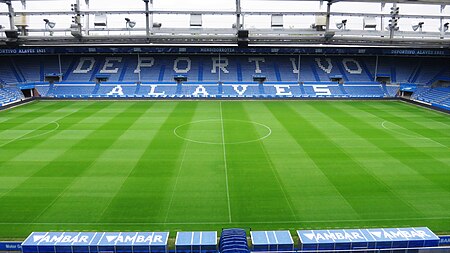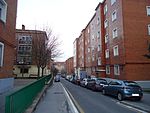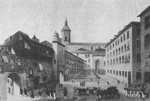Vitoria-Gasteiz (Spanish: [biˈtoɾja ɣasˈtejθ, -ɣasˈtejs]; Basque: [bitoɾja ɣas̺teis̻]), also alternatively spelled as Vittoria in older English-language sources, is the seat of government and the capital city of the Basque Country and of the province of Álava in northern Spain. It holds the autonomous community's House of Parliament, the headquarters of the Government, and the Lehendakari's (Prime Minister's) official residency. The municipality—which comprises not only the city but also the mainly agricultural lands of 63 villages around—is the largest in the Basque Country, with a total area of 276.81 square kilometres (106.88 sq mi), and it has a population of 253,093 (January 2021). The dwellers of Vitoria-Gasteiz are called vitorianos or gasteiztarrak, while traditionally they are dubbed babazorros (Basque for 'bean sacks').
Vitoria-Gasteiz is a dynamic city with strengths in healthcare, aeronautics, the automotive industry, and viticulture. It is consistently ranked as one of the 5 best places to live in Spain, ranking highly in quality of life and business opportunities, it is the first Spanish municipality to be awarded the title of European Green Capital (in 2012) and it has been also recognized by the UN with the Global Green City Award (in 2019). The old town has some of the best preserved medieval streets and plazas in the region and it is one of very few cities with two cathedrals. The city also holds well known festivals such as the Azkena rock festival, FesTVal, Vitoria-Gasteiz jazz festival, and the Virgen Blanca Festivities.
Vitoria-Gasteiz's vicinity is home to acclaimed wineries such as Ysios, designed by world-renowned architect Santiago Calatrava, and Marqués de Riscal, by Frank Gehry. Relevant heritage sites including the Neolithic remains of Aizkomendi, Sorginetxe and La chabola de la Hechicera; Iron Age remains such as the settlements of Lastra and Buradón; antique remains such as the settlement of La Hoya and the salt valley of Añana; and several medieval fortresses including the Tower of Mendoza and the Tower of Varona.
Ludwig van Beethoven dedicated his Opus 91, often called the "Battle of Vitoria" or "Wellington's Victory", to one of the most famous events of the Napoleonic Wars: the Battle of Vitoria, in which a Spanish, Portuguese and British army under the command of General the Duke of Wellington broke the French army and nearly captured the puppet king Joseph Bonaparte. It was a pivotal point in the Peninsular War, and a precursor to the expulsion of the French army from Spain. A memorial statue can be seen today in Virgen Blanca Square.











